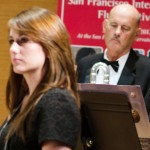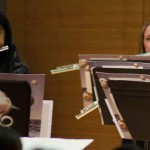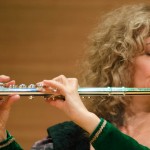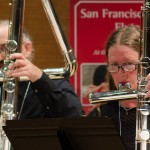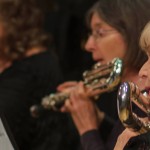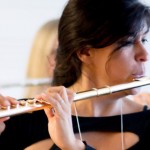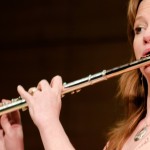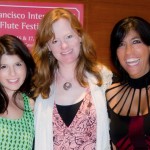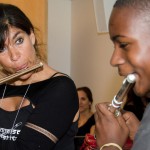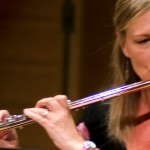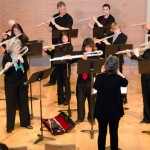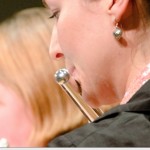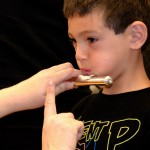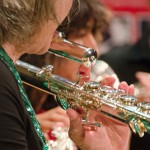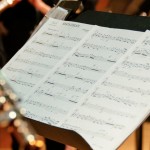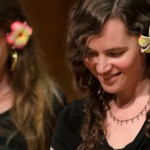Review of San Francisco International Flute Festival 2012
by Steven Weinmann
The second San Francisco International Flute Festival was held on June 16 and 17, 2012 at the San Francisco Conservatory of Music. The Festival expanded to two days, allowing room for more masterclasses and workshops, more flute choirs, and two gala concerts plus a bonus “evening” concert.
If the SFIFF had a theme this year, it would be “Innovation, Variety and Surprise.” The workshops and masterclasses included diverse topics like beatboxing (founder Viviana Guzmán), celtic music (Lars Johannesson), and alto flute (Dr. Kris Palmer).
On Day One, the Champagne Flutes flute choir kicked off the concerts with all three themes on display, playing a Bob Dylan tune “To make you feel my love,” which was not only an unusual choice but unexpectedly romantic, and then followed up with a medley of Michael Jackson tunes. Then they finished with “Rondeau” by Purcell. Further variety followed with the Camellia City Flute Choir providing a nature-themed set with “The Balcony Suite and Voices From the Deep,” ending with the ever-popular “Flight of the Bumblebee.”
For something completely different, Barbara Siesel and Keith Torgan offered “Green Golly and her Golden Flute,” a children’s fable including Siesel on flute and Torgan storytelling. Magicflutes Flute Orchestra then brought the concert back to classical, with Mozart, J.S. Bach and Saint-Saens.
The “Evening Concert” began with Dr. Kris Palmer playing the alto flute accompanied by piano on “Nicht Schnell,” which despite the title (“not fast” in German) went by perhaps too fast as hearing the alto flute as a feature is not a common occurrence. Dr. Palmer played to the piece’s strengths and let the audience enjoy the rich tone of the alto.
The program then took a surprise turn as the performers went out of the scheduled order, without an announcement (though the program did state that it was subject to change). This led to a bit of intrigue and fun for the packed house, who had a moment or two between performances in which to figure out who was about to play. Rebecca Kleinmann went next, and those expecting “just another flute song” were pleasantly surprised, as she substituted one piece for her song “Luz Do Sol” in which she sang in a jazz-smoky voice as well as playing her mellow flute, and was accompanied by guitar and percussion. Her other pieces were equally fluid and well-received.
Carol Alban, surprised herself by her pianist being unable to be there, substituted in the young and very musical Mads Tolling on violin, and he also played a bit of piano. Dealing with the unexpected with her typical good humor, Alban featured songs from her upcoming children’s jazz album (no surprise Alban lives in the Bay Area!) with sing-alongs and finger-snapping (to simulate rain). Her own composition “Harvest” and “Danny boy” (which she cheekily clarified that she did NOT write), were also well-received and well-played.
Another 180 degree turn was Ai Goldsmith’s wondrous classical performance of an orchestral piece by Japanese composer Hisatada Otaka. Looking elegant and poised, Goldsmith held the audience in rapt attention, mesmerized by her playing, which was flawless and featured her bell-like sound.
Shivhan Dohse then performed “Great Train Race” on solo flute, her energy and fast playing matching the theme of the song, the flute mimicking the train’s whistle and wheels, building to its exciting finish.
And then for something yet again different, Matt Eakle provided windows into the redwood forest and jazz theory. Eakle’s “Elk Creek” was composed and played first in a threatened redwood forest, and Eakle’s intro and playing evoked the wildness of the setting and the bittersweet occasion for the composition. He also played a “train song,” “Orange Blossom Special,” to different effect than Dohse’s on her piece, and then finished with Chick Corea’s “Spain,” playing with great passion on all pieces. Somewhere in between, and among some self-deprecating humor, he managed to explain the Phrygian scale and show how it can make a difference in a piece’s sound.
The first “Gala Concert”, on Saturday featured the headliners, starting with Festival Director and Founder Viviana Guzmán, who brought forth compelling “new” music, “The Road from Hana” by newcomer composer Rob Deemer, and her own “Spirit of Arwen,” ending with a beatbox piece, “3 Beats III” by Greg Pattillo. Each of the pieces had her employing non-traditional techniques in playing, voicing, singing and emoting to expand the songs’ emotional feel. New pieces for the somewhat limited flute repertoire are few and far between, and water to the desert sprang up with these flowers, particularly “Road from Hana,” living up to the beauty of the famous Hawaiian road. The always-daring and innovative Guzmán showed she has not stopped exploring new areas and new ways to play the flute, and the audience got to see her in both her creative and more traditional music incarnations, as she returned later to match notes with Gary Schocker on his set.
Nicole Esposito played engagingly and with clarity on two uplifting pieces on flute (Sonatina for flute and piano, and East Wind for solo flute). Then she changed over to piccolo, and shredded the air with the tiny instrument, in places reaching stratospherically high pitches, with her final piece being “Piccolo Italiano for piccolo and piano” by the next featured player, flutist/composer Gary Schocker. Piccolo players everywhere have found a champion; fortunately for them, Professor Esposito provides intensive summer workshops in the piccolo in her adopted State of Iowa.
After intermission, Gary Schocker took the stage and displayed a relaxed demeanor and dry humor in speaking to the crowd which only served to complement his masterful, seemingly effortless playing of his own complex pieces—all from memory. His tone was warm and rich, and his own pieces and one piece he embellished by Poulenc, “Un Jouer de Flute Berce Les Ruines” (for which he has tragically thus far been refused permission to publish), flowed with such beauty under his touch it was hard to believe they were not standards. They will be. One novelty he brought was “Ambidextrana,” on which he played flute and piano—at the same time. Likely few others will try to attempt it, but it was so well done one hopes he will keep performing it. After “Regrets and Resolutions,” another excellent piece, the audience wanted more and got it when Viviana Guzmán returned to join Schocker to perform “Three Dances for Two Flutes,” yet another of Schocker’s compositions. The two played the piece with precision and gusto, and seeing two such virtuosos trading notes was simply epic. The audience heartily agreed with a resounding standing ovation. Already a prolific composer, his performance of his works only whetted the appetite for more such gems to come from his pen and flute.
On Day Two, additional flute ensembles performed, each also added to the eclectic mix. Among other pieces, Avant Flute Choir of the San Jose Youth Orchestra played a milonga; Flock of Flutes another Schocker piece; and the inventive Areon Flutes played Michael Jackson’s “Thriller,” coming after the prior day’s Jackson medley, creating a mini-trend; and Bel Canto Flutes and GEMS flute choir played a Korean folk song.
The second Gala Concert capped off the weekend. San Francisco Symphony flutist Linda Lukas led an ensemble with cello and piano, in a piece by Louise Farrenc. Lukas explained that she had never heard of the composer until recently, but the tight performance by her and her group showed that they had worked hard to do the piece justice, and they certainly did. The three instruments played off of each other beautifully, and again, it was refreshing to hear a different and interesting piece.
Christina Jennings then gave a fiery performance that matched her red mane of hair. Her interpretation of variations on George Rochberg pieces, which she had transcribed from pieces written for violin, showcased her impeccable technique, including staccato double-tonguing and expressive flutter-tonguing. Then she did a lilting, airy rendition of a beautiful piece, “Chere Nuit” by Bachelet. At the end of the piece, it seemed like she and probably a few in the audience were about to tear up from the soaring feelings she had evoked. A slightly more subdued but also romantic piece, “Haru No Umi” by Miyagi, provided a good transition before what originally was to be her finale. Throughout the performance, her tone was akin to liquid gold. Her thrilling rendition of “Introduction and Rondo Capriccioso” by Saint-Saens brought a rousing applause. She had announced that she was coming back for another piece not on the program, but how she could surpass the dramatic and exciting last piece was a question that was on everyone’s mind. But none could have guessed what would happen next, as her Juilliard fellow alumna and friend, actress Jennifer Timm, came to the stage and announced that they would be performing a tribute to 12th century “early music” composer Hildegard von Bingen. The lights dimmed and Timm lit a candle, voicing Hildegard’s compositions. Jennings joined in on flute from the stage, while Timm, still singing / chanting, walked slowly up the center aisle in the darkened hall. Then the sounds of another flute arose softly from behind the audience; Viviana Guzmán had joined in to provide a warm but somehow haunting counterpoint to Jennings. For a few minutes, the hall became an ancient abbey as Timm with the help of her colleagues channeled von Bingen. The Festival had surprised yet again.
Mario Caroli had the unenviable position of performing last and after such great and varied performances, but Caroli’s big shoulders atop his tall frame bore the weight handily. The Italian chose three challenging pieces, sonatas by J.S. Bach, Debussy, and Jolivet, which required him to pour out every ounce of his considerable talent and soul. After the first two sonatas, it was clear that Caroli could be at times gentle and light and then firm and agile on the faster sections, switching back and forth instantly between tempos with lightning dexterity and precision. His delicate phrasing gave a nuanced depth to everything, each note conveying a promise of meaning, all wrapped in a silvery tone played on his platinum flute. To see his face emote along with the sounds, and his body contract and expand, it was as though you were watching and hearing the music flowing from the sheet music through him of its own accord. In the next piece, by Jolivet, the progressively heavy emotional tone of the movements, “Fluide” and “Grave,” built towards a crescendo in the third, “Violent,” in which the piercing notes and urgency made for an almost nervous, edgy feel. At the conclusion, the audience rewarded his outpouring of emotion and complete domination of these difficult pieces with a standing ovation. Caroli came back for an encore and delivered an appealing light-hearted solo piece, Casterede Etude No. 5, which he played with great sensitivity, and tenderness, leaving the audience with a final bit of dessert after the feast for the ears they had just enjoyed.
The San Francisco International Flute Festival in 2012 proved again the worth of the concept and the need for such a convocation in one of music’s most eclectic and vibrant cities. Gail Edwards, leading the combined flute choirs on Day Two, gave a generous donation to the Festival itself with the hope that it would inspire others to contribute towards the next festival. The opportunity to mix with fellow enthusiasts / players, and to see new faces and hear new performances, acts as a catalyst to creativity, as demonstrated by all of the variety and innovation which appeared at every turn this year. Director Sue Rupp, without whose tireless work and attention to detail the Festival would not have been possible, is to be congratulated on helping make the San Francisco International Flute Festival a truly premiere event.
STEVEN WEINMANN























